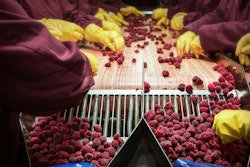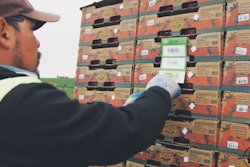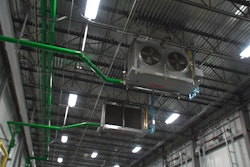
When Internet of Things (IoT) sensors, barcodes, scanners, automation and analytics first began making their way into industry, the vision for the food supply chain was that IoT technology would integrate into virtually every aspect of food operations from farm to fork.
Now it is happening.
On the Farm
To avoid waste in the field, agricultural producers have been focusing on ways to improve crop yields. Part of this effort is being devoted to a relatively new practice: precision agriculture (PA).
Precision agriculture is a farming method that takes into account the variability of soils, pests and crop yields depending on which portion of a field you are working. Because fields vary in terms of soil types, moisture content, contour and crop yield, how you plant corn over an entire area will also have to vary depending on your location in the field.
"To improve yields, producers use grid soil sampling to assist them in dealing with soil variability,” explains Carl Crozier, professor of crop and soil science and extension specialist at North Carolina State University (NCSU). “They take various soil samples from different areas of a field, mark these samples to the locations they were taken from, and then send the samples into the lab for fertilizer and lime recommendations. Once these are available, a map of the field showing their spatial variability must be created to guide precision management.”
The next step is to translate these results into ways that a producer can variably spread different proportions of fertilizers on different areas of a field based on the variability of soil, moisture, topography and so on. To do this efficiently, spreaders and other types of farm equipment now come with software and IoT sensors that can link into the geospatial coordinations of the different locations in the field and adjust the fertilizer mix to fit the individual prescriptions for these locations.
“In the future, we will expand the use of mounted cameras and view fields from above with UAVs (unmanned aerial vehicle),” adds NCSU associate professor of crop and soil sciences Jeff White. “This will aid farmers in detecting anomalies in the fields, such as variances in moisture or color—like when they see a yellow spot in an otherwise green field. Spectral analysis of blue, green, red and near infrared bands can be employed for the detection of nitrogen content and fertilizer need. This will help farmers achieve more granular levels of precision agriculture, so they can begin asking themselves whether they should add more nitrogen to certain areas of their fields.”
Food on the Move
Once the food leaves the farm, it enters into a stream of logistics, which can include warehousing, distribution and delivery to retailers.
“There is much to do in this area, because we’re still seeing 30 percent to 40 percent food waste levels post harvest, and half of this waste is occurring before food even gets to consumers,” says Peter Mehring, CEO of Zest Labs, an AgTech company introducing IoT technology into the post-harvest fresh food supply chain to improve food safety and reduce food waste. Mehring believes that food wholesalers and retailers can improve their profit margins and reduce food waste by 50 percent or more by using more IoT sensors and real-time analytics for food tracking and monitoring.
“Often, companies will attach sensors for tracking and monitoring to pallets, but not to the products themselves,” says Mehring. “What we really want to know is what the temperature and humidity conditions are with respect to the products, not to the ambient conditions of the environment a pallet is in.”
Karl Deily, president of food care at Sealed Air, which provides packaging solutions for foods and other industries, explains how more product-specific monitoring for spoilage prevention in food processing plants can be put into product packaging.
“A load of strawberries might come into a processing plant on the same date from the same field. You would assume that these strawberries would all carry the same expiration date, but there is a big freshness difference between strawberries that are picked in the cool of the early morning and those that are picked later in the day,” explains Deily.
Strawberries picked during cool early morning hours are likely to respirate less than the strawberries picked in the afternoon. “The less the strawberries respirate, the longer they will be fresh,” he adds.
In the processing plant, IoT sensors can monitor fruit respiration rates and freshness so that packaging with more respiratory perforations is prepared for the fruit that is respirating at a higher rate, while fresher fruit that is respirating at a lower rate is wrapped with packaging that contains fewer respiratory perforations.
“This is a way that we can adjust packaging to the conditions of particular products to preserve freshness and reduce spoilage,” says Deily.
From Farm to Fork
Once food arrives at distribution points, it is transported to retailers via truck, rail or plane. IoT plays two major roles in this process:
- First, it geographically tracks progress of goods to market, while feeding analytics systems that help determine the safest and speediest routes to market.
- Additionnally, it continuously measures the environmentals of the interiors of refrigerated trailers and the interiors of packages and containers that meats and produce are stored. If the seal of a container is broken, or temperature and humidity controls within the container fail, the sensors issue immediate alerts to supply chain managers so the situation can be mitigated. Together, these food track, trace and control mechanisms reduce spoilage and maintain the track and trace of foods from farm to table.
“You want to be able to collect sensor data at the level of the product,” says Mehring. “If a pallet of fruit is not pre-cooled and it is placed into a 34-degree trailer, all of that fruit will be respirating at a higher rate and generating heat, which creates a situation where the fruit will spoil sooner. But if the sensors are actually attached inside the cases with the product, the true temperatures that the products are maintained at can be measured, and you have a much more accurate picture of the state that your cargo is in and how much time you have to get it to market.”
Mehring says that Zest has developed a “ZIPR” (Zest Intelligent Pallet Routing) Code that dynamically calculates the freshness of each pallet tracked. “We use a patented methodology and sensors for this purpose, and the goal is to ensure that the inventory and shipping decisions that supply chain managers make are based on actual food freshness for each and every pallet.”
The ZIPR Code can tell a California producer in an eyeshot whether a product is fresh enough to be shipped across country to Boston, or whether freshness is already reduced and the manager needs to seek out a local market. By working with these predictive analytics, the producer can ship product expediently and effectively—and reduce food waste.
“Food waste is an important part of the food supply chain discussion—not only for producers, transporters and distributors, but for the retailers and consumers themselves,” adds Mehring. “Many of the retailers we work with, for example, expect a 30 percent waste level with lettuce of all different types. They see a harvest date on the lettuce and expect a 10-day shelf life based on this date, but only one third of the lettuce they source makes this date. Most of these retailers tell us that they get an average of 6.5 days shelf life for lettuce, regardless of what the expiration date says. This is where understanding the true ZIPR Code (or remaining freshness of products at harvest) and determining the best destinations to avoid spoilage can make an impact.”
The food freshness journey doesn't stop at the retailer, however. Today’s smart refrigerators also aid consumers in managing their food freshness and avoiding spoilage. These smart refrigerators can now read everything from a single label on a product, including where the product came from, what ingredients it contains, and what its current freshness is. The refrigerated appliance can even recommend to consumers which foods to eat first in order to avoid waste.
How important is this to today’s consumers?
In a 2016 Trace One survey, 68 percent of consumer respondents said they wanted to know more about what was in their food and where it came from. Food tags and IoT readers and sensors in smart refrigerators help them obtain that information.
Product Recalls
Finally, IoT technology can be a major deterrent to food recalls.
A food recall, whether due to spoilage, contamination or other factors, can have a multi-year or even a permanent effect on a company’s brand and reputation. More importantly, it is a threat to public health.
“Today, when food safety risks could be reduced via end-to-end supply chain visibility, product quality checks must go beyond simply obtaining a certificate of quality analysis at the point of loading,” says Stefan Reidy, CEO of Arviem Switzerland, which provides real-time cargo monitoring and tracking solutions. “When food spoilage and contamination are some of the biggest concerns in food supply chains, visibility should not end with suppliers of raw materials or intermediate goods. Food manufacturers must be able to monitor what’s happening to their shipment while in transit to see whether the goods were transported and stored under proper temperature conditions.”
Unfortunately, not all food manufacturers have adopted IoT to help with this problem, and many small producers and manufacturers lack funds to pursue IoT aggressively. This helped contribute to more than 20 million pounds of food being recalled in the United States in 2017, according to USDA statistics.
Industry executives like Reidy maintain that monitoring goods with IoT sensors during transportation “enables food manufacturers to verify the quality of ingredients before they are incorporated into a product. Moreover, during the times of recalls, traceability of products accelerates the investigation process, enabling professionals to identify the reasons for spoilage or contamination.”
A combination of barcoding and smart labeling technologies; IoT sensors for environmental and food safety factors during transport, yarding and warehousing; and use of cloud-based technology to store and process the results from continuous track and trace of foods can reduce the risk of food spoilage and contamination, improve consumer health, and protect companies from brand and reputation damage—not to mention lawsuits.
Next Steps
“One of the best ways to expand your use of IoT is to become aware of what others in your situation are or have done with it successfully. If you don't have the expertise, you can also benefit by looking for a vendor that has the right technology and the expertise, and that can be a good business partner,” says Seal Air’s Deily.
Second, when you find an IoT solution that you feel can assist you with food freshness and supply chain issues, trial it first. “The good news about much of this technology is that you can start with a relatively modest investment, and see if it proves out your business case,” explains Mehring.
Third, talk with your suppliers. The end goal of the food supply chain is to give everyone vested in it total visibility of the food it tracks and traces. If you've got IoT at your processing plant and in your logistics operations, but you don’t have it at some of your smaller farmer-producers, the links of the supply chain are broken and you don't have uninterrupted visibility. This is an area where you might be able assist your suppliers with IoT implementation, or possibly even with financing.
Fourth, if you are a retailer, don’t assume that you have to accept food waste at previous levels. “We get called in when a retailer has an acute problem. They already expect to lose points on their margin from food waste,” says Mehring. “But with the growth of IoT and other technologies in the food supply chain, there’s every reason to aim for better results.”



















